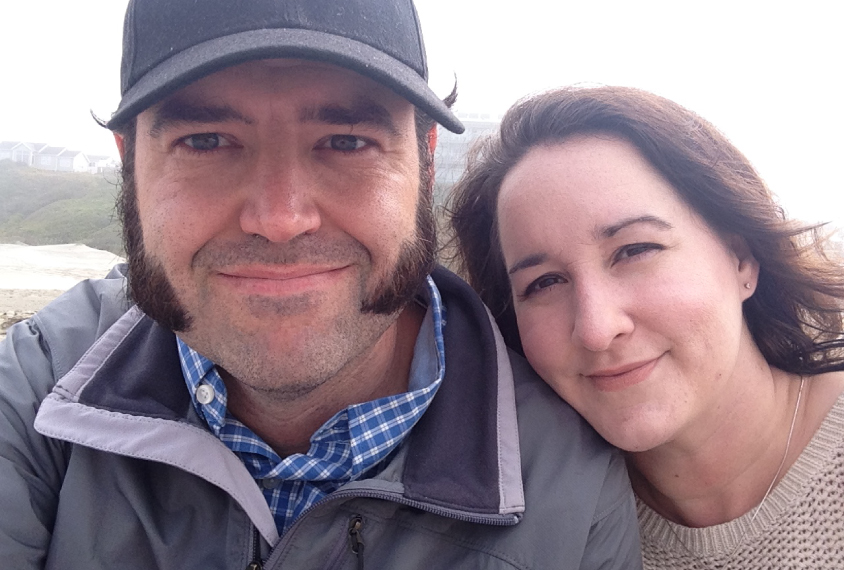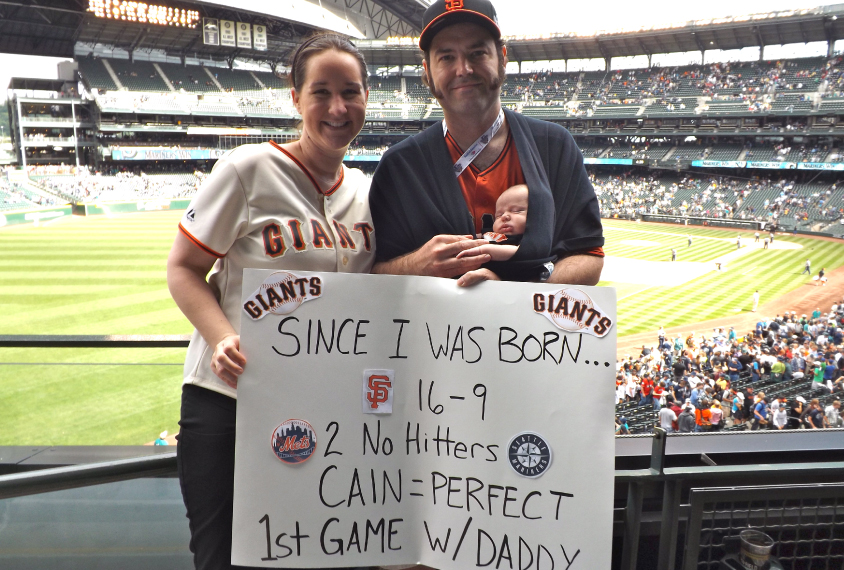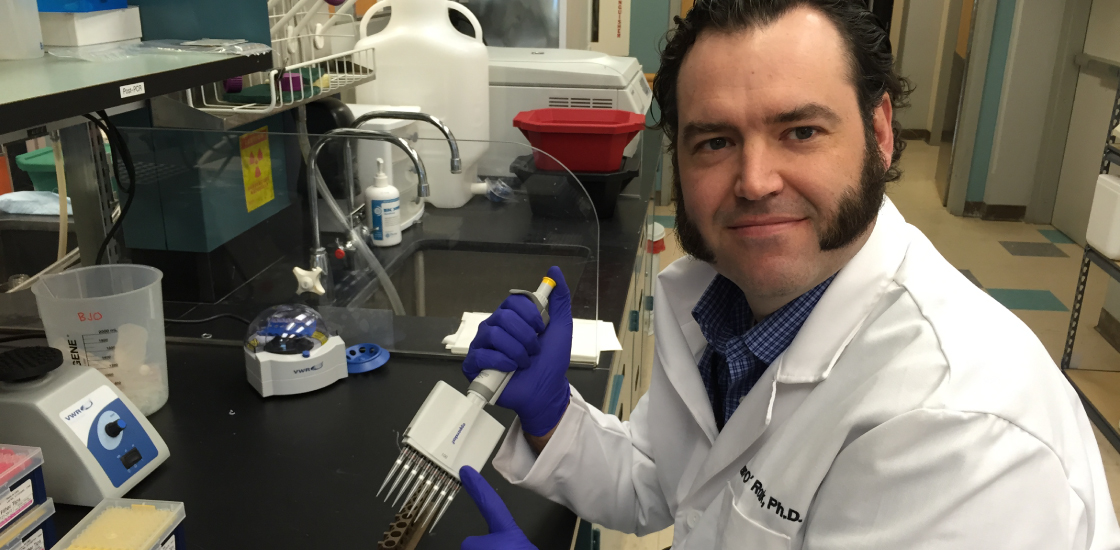THIS ARTICLE IS MORE THAN FIVE YEARS OLD
This article is more than five years old. Autism research — and science in general — is constantly evolving, so older articles may contain information or theories that have been reevaluated since their original publication date.
Brian O’Roak is rarely seen without a baseball cap. As a postdoctoral researcher, he was known for being intense and focused, sometimes responding to questions with a raised eyebrow beneath the bill of the cap, along with a noncommittal “Hmm …”
He may be no less intense or focused these days at Oregon Health and Science University (OHSU) in Portland, where he is assistant professor of molecular and medical genetics, but he’s also known as an unpretentious team leader who is willing to get his hands dirty in the lab. In lieu of rolling up his sleeves, he flips his trademark ball cap to the back of his head.
Eric Fombonne, a professor of psychiatry at OHSU who works closely with O’Roak, says he is impressed by his colleague’s mission to make an impact on the lives of people with autism. “It’s very nice to have a collaboration with a geneticist who is not only brilliant in his work, but is also compassionate and empathic,” Fombonne says.
The first in his family to earn a four-year college degree, O’Roak has, at 34, already become a serious player in autism genetics — a field with no shortage of stars. In fact, this die-hard baseball fan is the scientific equivalent of a five-tool player, a baseball player who excels at throwing, fielding and base-running, and hits balls hard and often.
“He knows the big problems, he knows the technology, he’s gifted at applying it. And he’s really, really good analytically,” says Matthew State, chair of psychiatry at the University of California, San Francisco and O’Roak’s graduate adviser.
O’Roak’s combination of skills has already paid off with some impressive wins, including papers in top journals such as Science and Nature. He has helped to steer some of the largest, most complex studies of autism genetics to date, managing the sequencing and analysis of reams of DNA from more than 2,000 individuals. Colleagues also credit him with the inspiration that many of the genes altered in autism belong to a network involved in DNA packaging.
Field of dreams:
O’Roak was raised in California’s Central Valley by a single mother who often drove him and his brother three hours each way to the Bay Area to attend the San Francisco Giants’ baseball games. In high school, a charismatic teacher sparked his interest in biology and genetics, and he spent the summer after his sophomore year in the lab of Timothy Ramsay, then at Louisiana State University in Baton Rouge, working with cells from genetically engineered obese mice.
“He knows the big problems. He knows the technology. He’s gifted at applying it. And he’s really, really good analytically.”
“Nothing I did worked. Everything got contaminated,” O’Roak recalls. “But it was still a great experience.”
As his high school graduation drew near, O’Roak was unsure what to study in college. Then the nearby Fresno campus of California State University offered him a tuition-free spot in its new undergraduate honors program, an opportunity that O’Roak found impossible to turn down. He joined a plant genetics lab and investigated the molecular genetics of a tiny worm that wreaks havoc on crops.
On his first day at Fresno State, in 1999, O’Roak met his future wife, Erin, a fellow honors student with an interest in business and marketing. The couple married after their junior year.
By his senior year, O’Roak knew he wanted to stay in research, but he wasn’t sure what exactly he wanted to work on or where. He applied to several programs, including one at Yale University because his undergraduate advisor, Alejandro Calderon-Urrea, had earned his Ph.D. in biology there. “I had never been to the East Coast and just really had no sense of what that would be like,” O’Roak says.
At the time, Matthew State had a lab at Yale and was looking for rare genetic variants associated with a range of psychiatric and neurodevelopmental disorders. O’Roak joined State’s lab in mid-2004 and jumped right into one of its trickiest projects.
His colleagues identified a chromosomal rearrangement in a child with Tourette syndrome, a condition characterized by vocal and motor tics, but puzzled over how to determine the significance of the genetic change. “He came up with a lot of the underlying ideas about how we thought about evaluating what we found,” says State.
Rookie success:
In casual conversation, O’Roak has an easygoing manner and a dry sense of humor. But when talk turns to the details of a scientific topic, he can become intense.

Base pair: O’Roak and his wife, Erin, are college sweethearts who met on their first day at Fresno State University.
State recalls a series of conversations late that year with O’Roak and Jesse Abelson, another graduate student, as they wrestled with the logic and statistics needed to prove that the gene disrupted by the rearrangement, SLITRK1, can cause Tourette’s. “I remember those really vividly because they were some of the most interesting and exciting and challenging interactions that a [scientist] can have with his or her trainees,” State says.
The researchers detailed their findings in a 2005 paper in Science — O’Roak’s first scientific publication1. “That kind of set the bar pretty high, I guess, moving forward,” he says with a wry grin.
Next, O’Roak got involved in the search for rare genetic variants in a gene known as CNTNAP22. The gene had been linked to autism and language impairments, but it wasn’t easy to replicate the success of the Tourette syndrome work. DNA sequencing methods at the time were laborious and time-consuming. Despite spending more than two years sequencing the gene in 2,000 people, O’Roak came up with frustratingly ambiguous results.
By 2009, when O’Roak was finishing his Ph.D., sequencing technology began to catch up with his ambitions. That November, he became a postdoctoral fellow at the University of Washington in Seattle, jointly assigned to the labs of Evan Eichler, a geneticist, and Jay Shendure, who develops tools for analyzing genomic data. There, O’Roak used the new faster and cheaper methods to sequence the protein-coding regions of the genome, or exomes, in families affected by autism.
As a trial run, O’Roak deciphered 60 exomes belonging to 20 children with autism and their unaffected parents. Four of the children had de novo mutations — genetic aberrations not inherited from either parent — that could potentially explain their autism. O’Roak and his colleagues reported the results in a 2011 paper in Nature Genetics3.
The finding hinted that de novo mutations contribute to autism, and that exome sequencing is a good way to find them. So O’Roak and his colleagues scaled up their efforts, decoding exomes from 209 families affected by autism.
Networking:
As he was connecting genetic mishaps to autism, O’Roak was also forging human ties. “He was kind of a glue between our lab and Evan’s lab,” Shendure says. “There are a lot of friendships and collaborations there that I think were really made possible by having him as that kind of common ingredient.”
He was also good at making molecular connections. At first, he says, he was “somewhat naïve,” assuming that all of the de novo mutations would land in a small set of genes. Instead, the mutations turned out to affect dozens of genes, rarely striking the same one twice.
As O’Roak read up on each of these genes, however, connections emerged. “Very strangely, I kept coming across the fact that gene A binds to gene B, and then later on I’d be reading about gene C and it would say it binds to gene B,” he says. He recalls thinking, “Hmm, that gene kind of seems familiar.”
This led O’Roak to wonder whether autism-linked mutations affect a large number of proteins that interact in a network — in particular, one that governs the packaging of DNA, a process known as chromatin remodeling.
Eichler was skeptical. The literature on protein-protein interactions is notoriously unreliable —incomplete and rife with purported connections between proteins that don’t really interact.
What’s more, at the time, most autism researchers were focused on synapses — the junctions between neurons. The idea that defects in DNA packaging might be important in the condition came out of left field.
Undaunted, O’Roak persevered in his theory. As he and his colleagues sequenced more exomes, they were able to show that only the people with autism in their study, and not those individuals’ siblings or parents, may have mutations in DNA-packaging genes. “I think that one of the most innovative things that he did when he was working in the lab is this idea of the pathways,” Eichler says.
Heavy hitter:
The results of this second exome sequencing study were published in the April 2012 alongside two other related papers in Nature4. The trio of studies blew open the field by suggesting that there might be hundreds of genes involved in autism.

Giant steps: While analyzing DNA from thousands of individuals, O’Roak also took on the massive project of fatherhood.
Eight months later, the researchers published a still larger study in Science in which they looked for de novo mutations in 44 genes in 2,446 individuals with autism. “That was a busy year,” says O’Roak, who also welcomed a baby boy in May 2012.
For the Science study, O’Roak drew on a technology known as a ‘molecular inversion probe’ that Shendure’s lab had developed but rarely used. The technique allows researchers to rapidly home in on and ‘resequence’ specific genes in a large number of individuals.
“That’s something that Brian basically brought back from the dead in my lab, and turned it into a really scalable platform,” Shendure says. “And that continues to be used in my lab and Evan’s lab and other labs around the world.”
Using the technique, O’Roak and his colleagues uncovered 17 severe de novo mutations, all but one of which affect genes in the chromatin remodeling network, confirming the importance of the network in autism5.
The elegant work has made a mark even outside of autism genetics. “I started thinking about ways I could apply the same approach,” says Aaron Gitler, associate professor of genetics at Stanford University, who studies the genetics of neurodegenerative diseases.
Moneyball science:
In 2013, O’Roak landed a faculty position at OHSU, where he continues to develop technologies to aid his hunt for mutations. He’s also working to parse the function of autism risk genes, aiming to eventually turn these insights into targeted treatments for autism.
In his free time, O’Roak brews beer and plays Gaelic football, a fast-paced mashup of sports that resembles rugby. “I haven’t sequenced my genome yet, but we definitely confirmed my Y chromosome was Irish when I was in Matt’s lab,” he quips.
Free time is scarce, however, and it’s about become more so: O’Roak and his wife are expecting another baby in February.
It isn’t easy to balance the demands of a growing family with those of a growing lab. O’Roak compares leading a lab as a young principal investigator to shepherding an underdog baseball team. He embraces baseball’s ‘moneyball’ approach, which involves the use of rigorous but unconventional statistics to identify passed-over players with promise — and to build a winning team on a budget. “How do you find really talented people who may have been overlooked by others?” he asks. He may have some perspective here: O’Roak was exactly that kind of player not long ago.

By joining the discussion, you agree to our privacy policy.